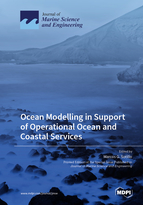Ocean Modelling in Support of Operational Ocean and Coastal Services
A special issue of Journal of Marine Science and Engineering (ISSN 2077-1312). This special issue belongs to the section "Ocean Engineering".
Deadline for manuscript submissions: closed (15 December 2021) | Viewed by 32240
Special Issue Editor
Special Issue Information
Dear Colleagues,
Operational oceanography is maturing rapidly. Its related capabilities are being noticeably enhanced in response to a growing demand of regularly-updated ocean information. Today, a number of core forecasting and monitoring services, focused on global and regional scales, are well-stablished. Sustained availability of their products has favored the proliferation of downstream services devoted to coastal monitoring and forecasting. Ocean models are a key component in operational oceanographic systems and ocean modeling progresses are a driver of service evolution (especially in a context marked by extensive application of dynamical downscaling approaches).
The goal of this Special Issue is to publish most exciting research (see below specific working lines) on ocean modeling with benefits in model applications that support existing operational oceanographic services. High-quality papers focused on combining ocean models with observational products, including data assimilation, are considered. Papers addressing model product quality assessments and evaluations of operational services capabilities to simulate outstanding marine processes/features and extreme events are also welcome.
Dr. Marcos G. Sotillo
Guest Editor
Manuscript Submission Information
Manuscripts should be submitted online at www.mdpi.com by registering and logging in to this website. Once you are registered, click here to go to the submission form. Manuscripts can be submitted until the deadline. All submissions that pass pre-check are peer-reviewed. Accepted papers will be published continuously in the journal (as soon as accepted) and will be listed together on the special issue website. Research articles, review articles as well as short communications are invited. For planned papers, a title and short abstract (about 100 words) can be sent to the Editorial Office for announcement on this website.
Submitted manuscripts should not have been published previously, nor be under consideration for publication elsewhere (except conference proceedings papers). All manuscripts are thoroughly refereed through a single-blind peer-review process. A guide for authors and other relevant information for submission of manuscripts is available on the Instructions for Authors page. Journal of Marine Science and Engineering is an international peer-reviewed open access monthly journal published by MDPI.
Please visit the Instructions for Authors page before submitting a manuscript. The Article Processing Charge (APC) for publication in this open access journal is 2600 CHF (Swiss Francs). Submitted papers should be well formatted and use good English. Authors may use MDPI's English editing service prior to publication or during author revisions.
Keywords
- Ocean model applications supporting operational services
- Seamless ocean modeling: global-to-coastal dynamical downscaling
- Ocean Models for short-term, seasonal, and climate regional predictions
- Operational model capabilities to predict extreme events
- Increasing interactions: coupling ocean/atmosphere/waves/hydrology/sea-ice
- Data Assimilation progresses: towards better ocean analysis
- Product quality assessment and demonstration of downscaling’s added value
- New approaches in operational services (based on ensembles, etc.)
- Ocean model links with biogeochemical systems
- Societal impacts of model predictions: user- and citizen-oriented uptakes






